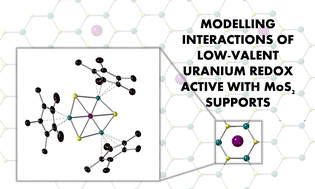Molybdenum sulphide clusters as redox-active supports for low-valent uranium†
Abstract
The preparation of an actinide substituted cubane cluster, (Cp*3Mo3S4)Cp*UI2, and its reduced derivatives are reported. Structural and spectroscopic investigations provide insight into the unique interactions between the actinide and its redox-active molybdenum sulphide metalloligand, serving as a model to study atomically-dispersed, low-valent actinide ions on MoS2 surfaces. To probe the ability of the assembly to facilitate multielectron small molecule activation, the reactivity of the fully-reduced cluster, (Cp*3Mo3S4)Cp*U, with azobenzene was investigated. Addition of the substrate results in the formation of a cis-bis-imido cluster, (Cp*3Mo3S4)Cp*U(![[double bond, length as m-dash]](https://www.rsc.org/images/entities/char_e001.gif) NPh)2. Cooperative reactivity between the actinide and redox-active support facilitates the 4e−-reduction of substrate.
NPh)2. Cooperative reactivity between the actinide and redox-active support facilitates the 4e−-reduction of substrate.

- This article is part of the themed collection: Chemical Communications HOT Articles 2024


 Please wait while we load your content...
Please wait while we load your content...